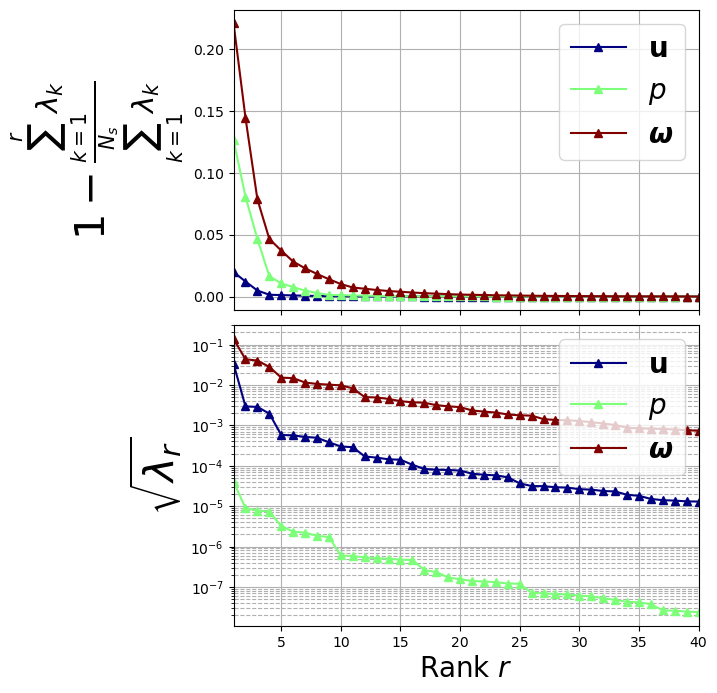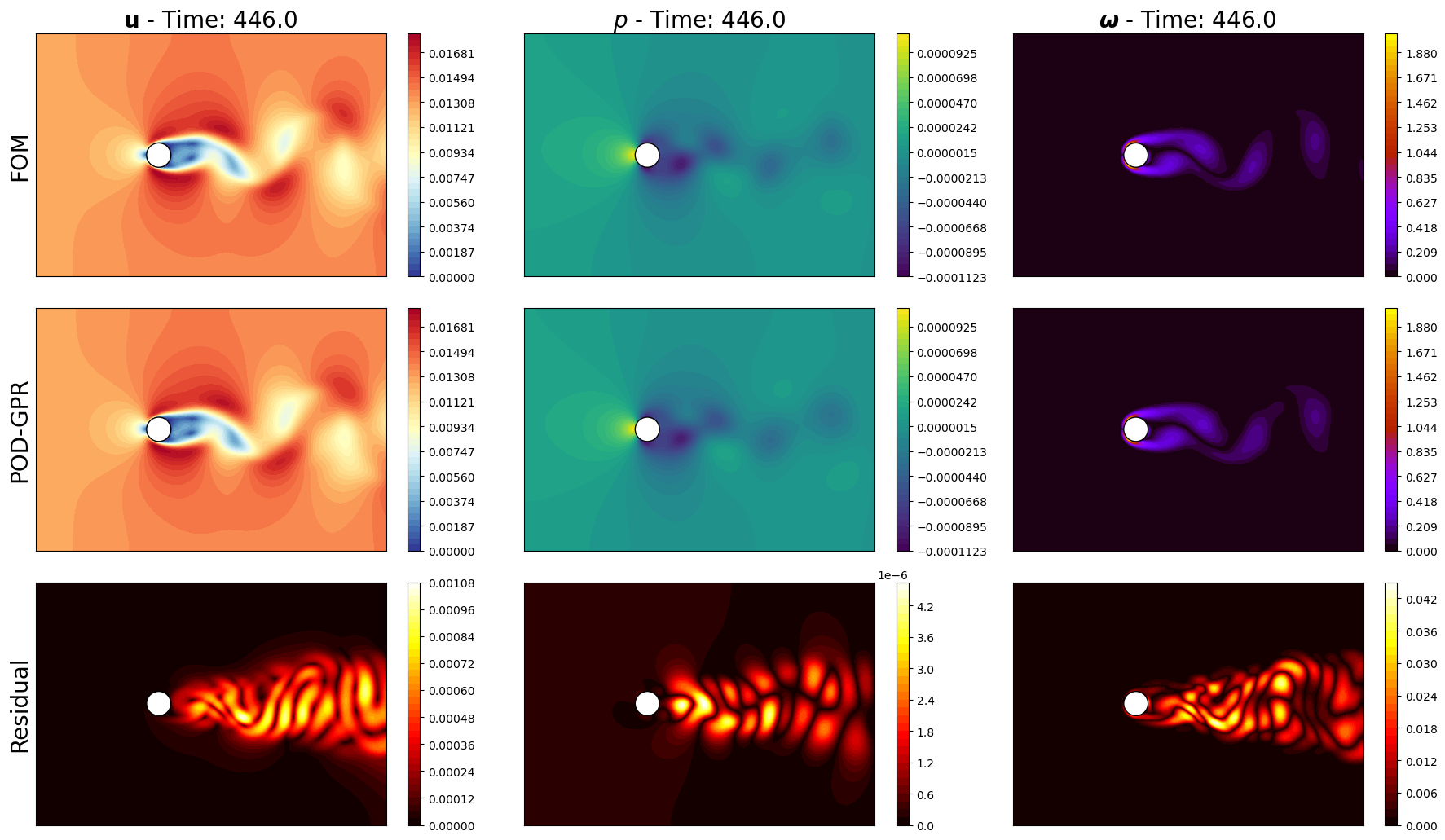POD with Gaussian Process Regression (GPR)
Aim of this tutorial: generate the POD modes from the snapshots for the Flow Over Cylinder problem using an accelerated version of the algorithm and create a reduced model using Gaussian Process Regression (GPR).
To execute this notebook: be sure to have the snapshots stored into npz format.
The snapshots are related to the laminar Flow Over Cylinder in fluid dynamics, governed by the Navier-Stokes equations. In particular, the snapshots have been generated using the tutorial case reported here.
[1]:
import numpy as np
_data = np.load('Snapshots/of_dataset.npz', allow_pickle=True)
of_snaps = _data['snaps'].item()
times = _data['time_values']
is_vector = _data['is_vector']
var_names = _data['var_names']
print(var_names)
['U' 'p' 'vorticity']
Let us define some tex variables for visualisation
[2]:
tex_var_names = [r'\mathbf{u}', 'p', r'\boldsymbol{\omega}']
The class ReadFromOF is able to generate a mesh for dolfinx from the OpenFOAM mesh, if the cells are either hexahedra or tetrahedra (no mixed cells).
[3]:
from pyforce.tools.write_read import ReadFromOF
of = ReadFromOF('OF_case/')
domain = of.create_mesh()
/Users/sriva/miniconda3/envs/ml/lib/python3.10/site-packages/ufl/__init__.py:244: UserWarning: pkg_resources is deprecated as an API. See https://setuptools.pypa.io/en/latest/pkg_resources.html. The pkg_resources package is slated for removal as early as 2025-11-30. Refrain from using this package or pin to Setuptools<81.
import pkg_resources
Hexahedron cells selected
Let us define the functional spaces and let us map the snapshots from OpenFOAM mesh to the dolfinx mesh.
[159]:
from dolfinx.fem import FunctionSpace
import ufl
snaps = dict()
fun_spaces = list()
for field_i, field in enumerate(var_names):
if is_vector[field_i]:
fun_spaces.append(FunctionSpace(domain, ufl.VectorElement("CG", domain.ufl_cell(), 1)))
else:
fun_spaces.append(FunctionSpace(domain, ('Lagrange', 1)))
snaps[field] = of.foam_to_dolfinx(fun_spaces[field_i], of_snaps[field],
verbose='Mapping field: ' + field)
Mapping field: U: 250.000 / 250.00 - 0.115 s/it
Mapping field: p: 250.000 / 250.00 - 0.041 s/it
Mapping field: vorticity: 250.000 / 250.00 - 0.117 s/it
Let us split the data into train and test
[160]:
from pyforce.tools.functions_list import train_test_split
train_snaps = dict()
test_snaps = dict()
for field in var_names:
train_times, test_times, train_snaps[field], test_snaps[field] = train_test_split(times, snaps[field],
test_size=0.2,
random_state=42)
Offline Phase: generation of the POD modes
We will use the POD class to generate the POD modes from the snapshots. The POD class is able to compute the POD modes using an accelerated version of the algorithm, exploiting the randomized SVD.
At first, the correlation matrix is computed and its eigenvalues and eigenvectors are calculated.
[161]:
from pyforce.offline.pod import POD as PODOffline
pod_offline = {
field: PODOffline(train_snap=train_snaps[field], name=field,
svd_acceleration_rank=40, verbose=True)
for field in var_names }
Computing U correlation matrix: 40.000 / 40.00 - 0.266 s/it
Computing p correlation matrix: 40.000 / 40.00 - 0.159 s/it
Computing vorticity correlation matrix: 40.000 / 40.00 - 0.269 s/it
Let us plot the eigenvalues
[162]:
import matplotlib.pyplot as plt
from matplotlib import cm
fig, axs = plt.subplots(2, 1, figsize=(6, 8), sharex=True)
color = iter(cm.jet(np.linspace(0, 1, len(var_names))))
# Plot on the first subplot
for field_i, field in enumerate(var_names):
c = next(color)
axs[0].plot(
np.arange(1, pod_offline[field].eigenvalues.size + 1, 1),
1 - np.cumsum(pod_offline[field].eigenvalues) / sum(pod_offline[field].eigenvalues),
"-^", c=c, label="$" + tex_var_names[field_i] + "$", linewidth=1.5
)
axs[1].semilogy(
np.arange(1, pod_offline[field].eigenvalues[:40].size + 1, 1),
np.sqrt(pod_offline[field].eigenvalues[:40]),
"-^", c=c, label="$" + tex_var_names[field_i] + "$", linewidth=1.5
)
axs[0].set_ylabel(r"$1- \frac{\sum_{k=1}^{r}\lambda_k}{\sum_{k=1}^{N_s} \lambda_k}$", fontsize=30)
axs[1].set_ylabel(r"$\sqrt{\lambda_r}$", fontsize=30)
for ax in axs:
ax.set_xticks(np.arange(0, 40 + 1, 5))
ax.set_xlim(1, 40)
ax.grid(which='major', linestyle='-')
ax.grid(which='minor', linestyle='--')
ax.legend(fontsize=20)
axs[1].set_xlabel(r"Rank $r$", fontsize=20)
fig.subplots_adjust(hspace=0.05)

Let us compute the POD modes and the POD coefficients.
[163]:
from pyforce.tools.backends import LoopProgress
Nmodes = [10,10,10]
train_pod_coeffs = dict()
test_pod_coeffs = dict()
for field_i, field in enumerate(var_names):
pod_offline[field].compute_basis(train_snaps[field], maxBasis=Nmodes[field_i])
bar = LoopProgress(msg = f"Computing Train POD coefficients for {field}",
final = len(train_snaps[field]))
train_pod_coeffs[field] = np.zeros((len(train_snaps[field]), Nmodes[field_i]))
for tt in range(len(train_snaps[field])):
train_pod_coeffs[field][tt] = pod_offline[field].projection(train_snaps[field](tt),
N=Nmodes[field_i])
bar.update(1)
del bar
bar = LoopProgress(msg = f"Computing Test POD coefficients for {field}",
final = len(test_snaps[field]))
test_pod_coeffs[field] = np.zeros((len(test_snaps[field]), Nmodes[field_i]))
for tt in range(len(test_snaps[field])):
test_pod_coeffs[field][tt] = pod_offline[field].projection(test_snaps[field](tt),
N=Nmodes[field_i])
bar.update(1)
del bar
Computing Train POD coefficients for U: 200.000 / 200.00 - 0.113 s/it
Computing Test POD coefficients for U: 50.000 / 50.00 - 0.114 s/it
Computing Train POD coefficients for p: 200.000 / 200.00 - 0.075 s/it
Computing Test POD coefficients for p: 50.000 / 50.00 - 0.075 s/it
Computing Train POD coefficients for vorticity: 200.000 / 200.00 - 0.114 s/it
Computing Test POD coefficients for vorticity: 50.000 / 50.00 - 0.112 s/it
Training Phase: Gaussian Process Regression (GPR)
Using the GaussianProcessRergression class from sklearn, we can train a GPR model on the POD coefficients. The GPR model will be used to reconstruct the POD coefficients: the input is represented by some pressure measurements, and the output is the POD coefficients.
[164]:
np.random.seed(42)
idx_sens_locs = np.random.choice(np.arange(train_snaps['p'].fun_shape), 5, replace=False)
train_measures = train_snaps['p'].return_matrix()[idx_sens_locs]
test_measures = test_snaps['p'].return_matrix()[idx_sens_locs]
# plt.plot(train_times, train_measures.T, 'o', label='Train measures')
from sklearn.preprocessing import MinMaxScaler, StandardScaler
input_scaler = MinMaxScaler()
input_scaler.fit(train_measures.T)
stacked_train_coeffs = np.hstack([
train_pod_coeffs[field] for field in var_names
])
stacked_test_coeffs = np.hstack([
test_pod_coeffs[field] for field in var_names
])
output_scaler = StandardScaler()
output_scaler.fit(stacked_train_coeffs)
[164]:
StandardScaler()In a Jupyter environment, please rerun this cell to show the HTML representation or trust the notebook.
On GitHub, the HTML representation is unable to render, please try loading this page with nbviewer.org.
Parameters
| copy | True | |
| with_mean | True | |
| with_std | True |
Let us train the GPR model on the POD coefficients: a multiple-input multiple-output (MIMO) model is trained, where the inputs are the pressure measurements and the outputs are the POD coefficients.
[165]:
from sklearn.gaussian_process.kernels import RBF, ConstantKernel, WhiteKernel
# Define the kernel for the Gaussian Process
kernels = dict()
for rr in range(sum(Nmodes)):
kernels[rr] = 1.0 * RBF(length_scale=1, length_scale_bounds=(1e-6, 1e2)) + WhiteKernel(
noise_level=1, noise_level_bounds=(1e-6, 1e2)
)
from sklearn.gaussian_process import GaussianProcessRegressor
# Train the GPR models
gpr_models = GaussianProcessRegressor(
kernel=kernels[rr], n_restarts_optimizer=10, alpha=1e-6, normalize_y=False
)
gpr_models.fit(input_scaler.transform(train_measures.T),
output_scaler.transform(stacked_train_coeffs))
[165]:
GaussianProcessRegressor(alpha=1e-06,
kernel=1**2 * RBF(length_scale=1) + WhiteKernel(noise_level=1),
n_restarts_optimizer=10)In a Jupyter environment, please rerun this cell to show the HTML representation or trust the notebook. On GitHub, the HTML representation is unable to render, please try loading this page with nbviewer.org.
Parameters
| kernel | 1**2 * RBF(le...noise_level=1) | |
| alpha | 1e-06 | |
| optimizer | 'fmin_l_bfgs_b' | |
| n_restarts_optimizer | 10 | |
| normalize_y | False | |
| copy_X_train | True | |
| n_targets | None | |
| random_state | None | |
| kernel__k1 | 1**2 * RBF(length_scale=1) | |
| kernel__k2 | WhiteKernel(noise_level=1) | |
| kernel__k1__k1 | 1**2 | |
| kernel__k1__k2 | RBF(length_scale=1) | |
| kernel__k1__k1__constant_value | 1.0 | |
| kernel__k1__k1__constant_value_bounds | (1e-05, ...) | |
| kernel__k1__k2__length_scale | 1 | |
| kernel__k1__k2__length_scale_bounds | (1e-06, ...) | |
| kernel__k2__noise_level | 1 | |
| kernel__k2__noise_level_bounds | (1e-06, ...) |
Test/Online Phase: reconstruction of the POD coefficients
We can now use the trained GPR model to reconstruct the POD coefficients from the pressure measurements.
[166]:
new_t = np.linspace(min(times), max(times), 1000)
sorting_train_idx = np.argsort(train_times)
new_measures = np.zeros((len(idx_sens_locs), len(new_t)))
for mm in range(len(train_measures)):
new_measures[mm] = np.interp(new_t, train_times[sorting_train_idx], train_measures[mm, sorting_train_idx])
predicted_gpr_coeffs, gpr_std = gpr_models.predict(input_scaler.transform(new_measures.T), return_std=True)
predicted_gpr_coeffs = output_scaler.inverse_transform(predicted_gpr_coeffs)
gpr_std = output_scaler.inverse_transform(gpr_std) - output_scaler.mean_[None,:]
Let us make a plot for each field
[167]:
for field_i, field in enumerate(var_names):
nrows = 2
ncols = 5
fig, axs = plt.subplots(nrows, ncols, figsize=(5 * ncols, 3 * nrows), sharex=True)
axs = axs.flatten()
for rr in range(nrows * ncols):
axs[rr].plot(new_t, predicted_gpr_coeffs[:, rr+sum(Nmodes[:field_i])], label='GPR prediction', color='r')
axs[rr].fill_between(new_t,
predicted_gpr_coeffs[:, rr+sum(Nmodes[:field_i])] - gpr_std[:, rr+sum(Nmodes[:field_i])],
predicted_gpr_coeffs[:, rr+sum(Nmodes[:field_i])] + gpr_std[:, rr+sum(Nmodes[:field_i])],
alpha=0.2, color='r', label='GPR uncertainty')
axs[rr].plot(test_times, test_pod_coeffs[field][:, rr], 'o', label='Test POD coeffs', color='b')
axs[rr].set_ylabel(r'$v_'+str(rr+1)+'^{'+tex_var_names[field_i]+'}$', fontsize=20)
if rr >= ncols:
axs[rr].set_xlabel('Time', fontsize=20)
axs[rr].grid()
_line, _labels = axs[0].get_legend_handles_labels()
fig.legend(_line, _labels, loc='upper center', fontsize=20, ncols=3)
fig.subplots_adjust(top=0.875, wspace=0.375, hspace=0.1)
plt.show()



Let us make some contour plots using matplotlib to visualize the reconstructed fields and show a different way of plotting
[ ]:
.shape
(70396, 50)
[198]:
from matplotlib import patches
from IPython.display import clear_output as clc
def get_mag(u_vec):
"""
Function to get the magnitude of a vector field in FEniCSx format (data are assumed 2D).
"""
u = u_vec[0::3]
v = u_vec[1::3]
w = u_vec[2::3]
return np.sqrt(u**2 + v**2 + w**2)
class PlotFlowCyl():
def __init__(self, domain, centre = (0., 0.0), radius = 0.06):
self.domain = domain
width = np.max(domain[:,0]) - np.min(domain[:,0])
height = np.max(domain[:,1]) - np.min(domain[:,1])
self.aspect = height / width
self.centre = centre
self.radius = radius
def create_circle(self, ls=1):
circle = patches.Circle(self.centre, self.radius, edgecolor='black', facecolor='white', linewidth=ls)
return circle
def plot_contour(self, ax, snap, cmap = cm.RdYlBu_r, levels=40, show_ticks=False):
if snap.shape[0] == 3*self.domain.shape[0]:
snap = get_mag(snap)
plot = ax.tricontourf(self.domain[:,0], self.domain[:,1], snap, cmap=cmap, levels=levels)
ax.add_patch(self.create_circle())
if not show_ticks:
ax.set_xticks([])
ax.set_yticks([])
return plot
plotter = PlotFlowCyl(domain=domain.geometry.x)
cmaps = [cm.RdYlBu_r, cm.viridis, cm.gnuplot]
sorting_test_idx = np.argsort(test_times)
sampling = 5
for ll in range(sampling, len(test_times), sampling):
tt = sorting_test_idx[ll]
predicted_gpr_coeffs = gpr_models.predict(input_scaler.transform(test_measures.T), return_std=False)
predicted_gpr_coeffs = output_scaler.inverse_transform(predicted_gpr_coeffs)[tt]
nrows = 3
ncols = len(var_names)
fig, axs = plt.subplots(nrows, ncols, figsize=(6 * ncols, 5 * nrows * plotter.aspect))
for field_i, field in enumerate(var_names):
levels = np.linspace(np.min(get_mag(test_snaps[field].return_matrix())),
np.max(get_mag(test_snaps[field].return_matrix())), 40) if is_vector[field_i] else np.linspace(np.min(test_snaps[field].return_matrix()),
np.max(test_snaps[field].return_matrix()), 40)
pod_recon = pod_offline[field].PODmodes.lin_combine(predicted_gpr_coeffs[sum(Nmodes[:field_i]):sum(Nmodes[:field_i+1])])
cont = plotter.plot_contour(axs[0, field_i], test_snaps[field](tt), cmap=cmaps[field_i], levels=levels, show_ticks=False)
plotter.plot_contour(axs[1, field_i], pod_recon, cmap=cmaps[field_i], levels=levels, show_ticks=False)
residual = np.abs(test_snaps[field](tt) - pod_recon)
res_cont = plotter.plot_contour(axs[2, field_i], residual, cmap=cm.hot, levels=40, show_ticks=False)
fig.colorbar(cont, ax=axs[0, field_i], orientation='vertical', pad=0.05)
fig.colorbar(cont, ax=axs[1, field_i], orientation='vertical', pad=0.05)
fig.colorbar(res_cont, ax=axs[2, field_i], orientation='vertical', pad=0.05)
axs[0, field_i].set_title(r'$' + tex_var_names[field_i] + r'$ - Time: ' + str(round(test_times[tt], 2)), fontsize=20)
axs[0,0].set_ylabel('FOM', fontsize=20)
axs[1,0].set_ylabel('POD-GPR', fontsize=20)
axs[2,0].set_ylabel('Residual', fontsize=20)
plt.tight_layout()
plt.show()
clc(wait=True)
plt.close(fig)
